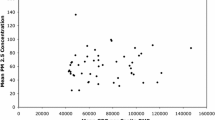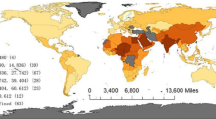Abstract
Much research has been conducted to find evidence of the environmental Kuznets curve (EKC) in the relationship between air-pollutant concentration and economic development. A major focus of EKC-related research has so far been to identify the turning point illustrated by EKC theory or to predict the moment when the turning point will occur. In our research, via analyzing the relationship between an aggregate social-development-representative variable (the Socio-demographic Index or SDI) and the population-weighted concentration of PM2.5, we propose that the overall relationship takes the form of a tilted-S shape with two types of turning points rather than one. Additionally, our research shows that the EKC is highly country-specific, making it extremely difficult to predict the positions of both turning points based on the historical development or trajectories of other countries. Therefore, we conclude that EKC theory is not a useful tool to predict the location of the turning points. However, for short-term prediction of the relationship, we advocate the use of support vector regression, which can forecast the evolution, unless rapid changes are occurring. We suggest that policy makers should not anchor their hopes on predicting turning points from previous studies, but should put more effort into dealing with present particulate matter pollution.








Similar content being viewed by others
Abbreviations
- EKC:
-
environmental kuznets curve
- SDI:
-
Socio-demographic index
- PWC:
-
population-weighted concentration
- SVR:
-
support vector regression
- GBD:
-
Global burden of diseases, injuries, and risk factors study
References
Dinda S (2004) Environmental Kuznets Curve hypothesis: a survey. Ecol Econ 49:431–455. https://doi.org/10.1016/j.ecolecon.2004.02.011
Dong B, Cao C, Lee SE (2005) Applying support vector machines to predict building energy consumption in tropical region. Energy Build 37:545–553. https://doi.org/10.1016/j.enbuild.2004.09.009
Dong K, Sun R, Dong C, Li H, Zeng X, Ni G (2018) Environmental Kuznets curve for PM2.5 emissions in Beijing, China: what role can natural gas consumption play? Ecol Indic 93:591–601. https://doi.org/10.1016/j.ecolind.2018.05.045
Forouzanfar MH et al. (2016) Global, regional, and national comparative risk assessment of 79 behavioural, environmental and occupational, and metabolic risks or clusters of risks, 1990–2015: a systematic analysis for the Global Burden of Disease Study 2015. Lancet 388:1659–1724. https://doi.org/10.1016/S0140-6736(16)31679-8
Gaddis GM, Gaddis ML (1990) Introduction to biostatistics: Part 5, statistical inference techniques for hypothesis testing with nonparametric data. Ann Emerg Med 19:1054–1059. https://doi.org/10.1016/S0196-0644(05)82571-5
Gakidou E et al. (2017) Global, regional, and national comparative risk assessment of 84 behavioural, environmental and occupational, and metabolic risks or clusters of risks, 1990–2016: a systematic analysis for the Global Burden of Disease Study 2016. Lancet 390:1345–1422. https://doi.org/10.1016/S0140-6736(17)32366-8
Grossman GM, Krueger AB (1991) Environmental impacts of a North American free trade agreement. National Bureau of Economic Research, Prepared for the Conference on the U.S. - Mexico Free Trade Agreement
Jain RK, Smith KM, Culligan PJ, Taylor JE (2014) Forecasting energy consumption of multi-family residential buildings using support vector regression: investigating the impact of temporal and spatial monitoring granularity on performance accuracy. Appl Energy 123:168–178. https://doi.org/10.1016/j.apenergy.2014.02.057
Ji X, Yao Y, Long X (2018) What causes PM2.5 pollution? Cross-economy empirical analysis from socioeconomic perspective. Energy Policy 119:458–472. https://doi.org/10.1016/j.enpol.2018.04.040
Kaika D, Zervas E (2013) The Environmental Kuznets Curve (EKC) theory-Part A: concept, causes and the CO2 emissions case. Energy Policy 62:1392–1402. https://doi.org/10.1016/j.enpol.2013.07.131
Lapinskiene G, Tvaronavičiene M, Vaitkus P (2014) Greenhouse gases emissions and economic growth - evidence substantiating the presence of environmental Kuznets curve in the EU. Technol Economic Dev Econ 20:65–78. https://doi.org/10.3846/20294913.2014.881434
Leisch DMaEDaKHaAWaF (2018) e1071: Misc Functions of the Department of Statistics, Probability Theory Group. (Formerly: E1071), TU Wien
Liu L (2008) Sustainability efforts in China: reflections on the environmental Kuznets curve through a locational evaluation of “Eco-Communities”. Ann Assoc Am Geogr 98:604–629. https://doi.org/10.1080/00045600802013452
Luo K, Li G, Fang C, Sun S (2018) PM2.5 mitigation in China: socioeconomic determinants of concentrations and differential control policies. J Environ Manag 213:47–55. https://doi.org/10.1016/j.jenvman.2018.02.044
Managi S (2006) Are there increasing returns to pollution abatement? Empirical analytics of the Environmental Kuznets Curve in pesticides. Ecol Econ 58:617–636. https://doi.org/10.1016/j.ecolecon.2005.08.011
Pui DYH, Chen S-C, Zuo Z (2014) PM2.5 in China: Measurements, sources, visibility and health effects, and mitigation. Particuology 13:1–26. https://doi.org/10.1016/j.partic.2013.11.001
R Core Team (2017) R: A Language and Environment for Statistical Computing. https://rstudio.com/
Roth GA et al. (2018) Global, regional, and national age-sex-specific mortality for 282 causes of death in 195 countries and territories, 1980–2017: a systematic analysis for the Global Burden of Disease Study 2017. Lancet 392:1736–1788. https://doi.org/10.1016/S0140-6736(18)32203-7
Solarin SA, Al-Mulali U, Musah I, Ozturk I (2017) Investigating the pollution haven hypothesis in Ghana: an empirical investigation. Energy 124:706–719. https://doi.org/10.1016/j.energy.2017.02.089
Stanaway JD et al. (2018) Global, regional, and national comparative risk assessment of 84 behavioural, environmental and occupational, and metabolic risks or clusters of risks for 195 countries and territories, 1990–2017: a systematic analysis for the Global Burden of Disease Study 2017. Lancet 392:1923–1994. https://doi.org/10.1016/S0140-6736(18)32225-6
Stern DI (2017) The environmental Kuznets curve after 25 years. J Bioeconomics 19:7–28. https://doi.org/10.1007/s10818-017-9243-1
Stern DI, Zha D (2016) Economic growth and particulate pollution concentrations in China Environmental Economics and Policy. Studies 18:327–338. https://doi.org/10.1007/s10018-016-0148-3
Vapnik V (2013) The nature of statistical learning theory. Springer science & business media, Springer-Verlag, New York. https://doi.org/10.1007/978-1-4757-3264-1
Wu J, Zheng H, Zhe F, Xie W, Song J (2018) Study on the relationship between urbanization and fine particulate matter (PM2.5) concentration and its implication in China. J Clean Prod 182:872–882. https://doi.org/10.1016/j.jclepro.2018.02.060
Yeganeh B, Motlagh MSP, Rashidi Y, Kamalan H (2012) Prediction of CO concentrations based on a hybrid Partial Least Square and Support Vector Machine model. Atmos Environ 55:357–365. https://doi.org/10.1016/j.atmosenv.2012.02.092
Acknowledgements
NL is supported by the Chinese Scholarship Council for his PhD study. We also gratefully acknowledge colleagues in the International Laboratory for Air Quality and Health, Dr. Helen Thompson from Queensland University of Technology, and Professor Lana Friesen from The University of Queensland for their advice. We would like to thank the two anonymous reviewers as well for their suggestions have greatly helped to improve this paper.
Author information
Authors and Affiliations
Corresponding author
Ethics declarations
Conflict of Interest
The authors declare that they have no conflict of interest.
Additional information
Publisher’s note Springer Nature remains neutral with regard to jurisdictional claims in published maps and institutional affiliations.
Supplementary information
Rights and permissions
About this article
Cite this article
Liu, N., Morawska, L. The Relationship between Social Development and Ambient Particulate Matter Pollution: Can We Predict The Turning Points?. Environmental Management 66, 278–287 (2020). https://doi.org/10.1007/s00267-020-01299-0
Received:
Accepted:
Published:
Issue Date:
DOI: https://doi.org/10.1007/s00267-020-01299-0




